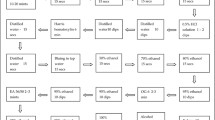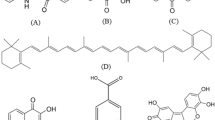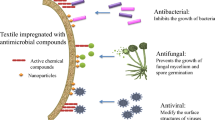Abstract
One of the most important pieces of evidence to find the suspect of a sexual assault are semen stains. It has been observed that suspects do not use condoms in many cases and transfer seminal fluids over the body of the victim, to their clothes, to bed linen, or to other objects in the environment. However, in many cases, it has been seen that the suspects or the victims tend to clean their bodies and clothes because of psychological conditions such as fear, panic, and anxiety. This study aims to determine whether human identification can be accomplished from washed semen stains by evaluating the quantity of extracted DNA obtained from washed clothes. In this study, both cotton- and nylon-blended fabrics were stained with semen samples taken from 10 volunteers and washed with detergent at 40 °C, 60 °C, and 90 °C. After stains were made re-visible using an ultraviolet (UV) light source, DNA was extracted using two different extraction methods (phenol–chloroform and spin-column). As a result, DNA extraction methods, washing conditions, and obtained DNA quantity from different washed fabrics were compared. It was shown that DNA could be obtained from all samples and that these DNA amounts could be used to perform identification. This study gives hope to the victims who have not been able to go to the judicial units immediately after the incident for fear or any other reasons and who think that they cannot get results because they have washed the laundry.







Similar content being viewed by others
Data availability
Not applicable.
References
Brayley-Morris H, Sorrellb A, Revoirc AP, Meakina GE, Courtc DS, Morgana RM (2015) Persistence of DNA from laundered semen stains: implications for child sex trafficking cases. Forensic Sci Int Genet. 19(165):171. https://doi.org/10.1016/j.fsigen.2015.07.016
Kulstein G, Schacker U, Wiegand P (2018) Old meets new: comparative examination of conventional and innovative RNA-based methods for body fluid identification of laundered seminal fluid stains after modular extraction of DNA and RNA. Forensic Sci Int Genet 36:130–140. https://doi.org/10.1016/j.fsigen.2018.06.017
Nolan A, Speers SJ, Murakamib J, Chapmana B (2018) A pilot study: the effects of repeat washing and fabric type on the detection of seminal fluid and spermatozoa. Forensic Sci Int 289:51–56. https://doi.org/10.1016/j.forsciint.2018.05.021
Kobilinsky L (1992) Recovery and stability of DNA in samples of forensic science significance. Forensic Sci Rev 4(1):67–87
Stray JE, Liu JY, Brevnov MG, Shewale JG (2010) Extraction of DNA from forensic biological samples for genotyping. Forensic Sci Rev. 2:159–75
Stray JE, Shewale JG (2010) Extraction of DNA from human remains. Forensic Sci Rev 2:177–85
Comey CT, Koons BW, Presley KW, Smerick JB, Sobieralski CA, Stanley DM, Baechtel FS (1994) DNA extraction strategies for amplified fragment length polymorphism analysis. J Forensic Sci 39:1254–1269
Butler JM (2012) Advanced topics in forensic DNA typing: methodology, 29–47. Academic Press, Massachusetts
Greenspoon SA, Scarpetta MA, Drayton ML, Turek SA (1998) QIAamp spin columns as a method of DNA extraction for forensic casework. J Forensic Sci 43:1024–1030
Montpetit SA, Fitch IT, O’Donnell PT (2005) A simple automated instrument for DNA extraction in forensic casework. J Forensic Sci 50:555–563
Castella V, Dimo-Simonin N, Brandt-Casadevall C, Mangin P (2006) Forensic evaluation of the QIAshredder/QIAamp DNA extraction procedure. Forensic Sci Int 156:70–73. https://doi.org/10.1016/j.forsciint.2005.11.012
QIAamp ®-DNA-Investigator-Handbook, extraction of total DNA from sexual assault specimens (2012), QIAGEN®, Germany.
Karaca M (2009) Forensic DNA analysis techniques pp. 97–105. Republic of Turkey Ministry of Interior, General Directorate of Security, KPL Department Publications. Publication No: KPL-BYL-001, EGM Administrative and Financial Affairs Department Printing House Branch Office, Ankara.
Veriti ™ 96-Well Thermal Cycler User Guide (2010), Applied Biosystems®, USA.
GlobalFiler ™ PCR Amplification Kit User Guide (2016), ThermoFisherScientific, USA.
3500 / 3500xL Genetic Analyzer, 3500 Series Software 2 User Guide (2013), Applied Biosystems®, USA
Noël S, Lagacé K, Raymond S, Granger D, Loyer M, Bourgoin S, Jolicoeur C, Séguin D (2019) Repeatedly washed semen stains: optimal screening and sampling strategies for DNA analysis. Forensic Sci Int Genet 38:9–14. https://doi.org/10.1016/j.fsigen.2018.10.002
Mussabekova S.A (2020) Possibilities of semen stain ıdentification after clothing and bedding washing in ınvestigating cases of sexual assault. Periódico Tchê Química, 17. https://doi.org/10.52571/PTQ.v17.n34.2020.111_P34_pgs_93_111.pdf
Acknowledgements
We thankfully acknowledge “The Institute of Addiction and Forensic Sciences of the Üsküdar University” for providing laboratory facilities.
Author information
Authors and Affiliations
Contributions
TUS and AG performed all analyses. NSK and AK prepared the primary draft. TUS and SA designed, conceptualized, edited, and supervised the entire work. All the authors read and approved the manuscript.
Corresponding author
Ethics declarations
Ethics approval and consent to participate
This study was carried out at Üsküdar University Institute of Addiction and Forensic Science Laboratories. All samples were obtained after written informed consent with Üsküdar University Non-Interventional Research Ethics Board approval in accordance with the Declaration of Helsinki and national laws. The study was initiated following the approval of the Üsküdar University Non-Interventional Research Ethics Committee, number 61351342-/2019–340.
Consent for publication
Not applicable.
Competing interests
The authors declare no competing interests.
Additional information
Publisher's note
Springer Nature remains neutral with regard to jurisdictional claims in published maps and institutional affiliations.
Rights and permissions
Springer Nature or its licensor (e.g. a society or other partner) holds exclusive rights to this article under a publishing agreement with the author(s) or other rightsholder(s); author self-archiving of the accepted manuscript version of this article is solely governed by the terms of such publishing agreement and applicable law.
About this article
Cite this article
Sapan, T.Ü., Güngör, A., Sandıkçı, N. et al. DNA recovery and human identification from semen stains washed at different temperatures. Int J Legal Med 137, 303–310 (2023). https://doi.org/10.1007/s00414-022-02937-4
Received:
Accepted:
Published:
Issue Date:
DOI: https://doi.org/10.1007/s00414-022-02937-4




